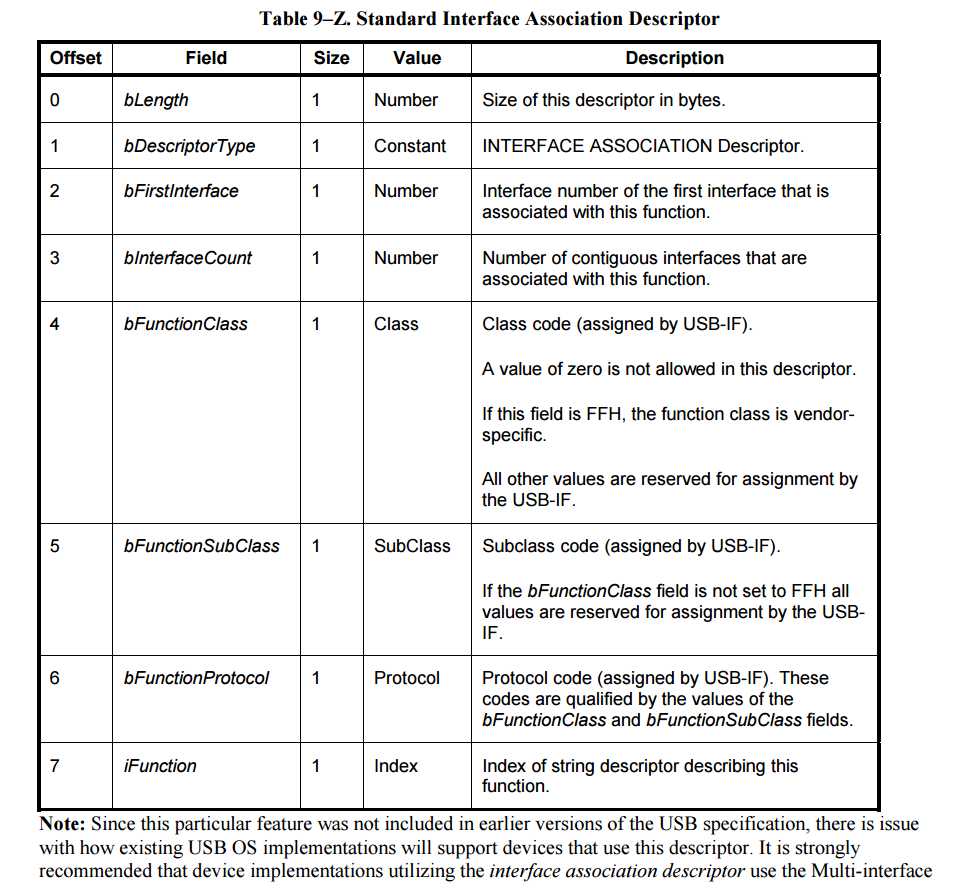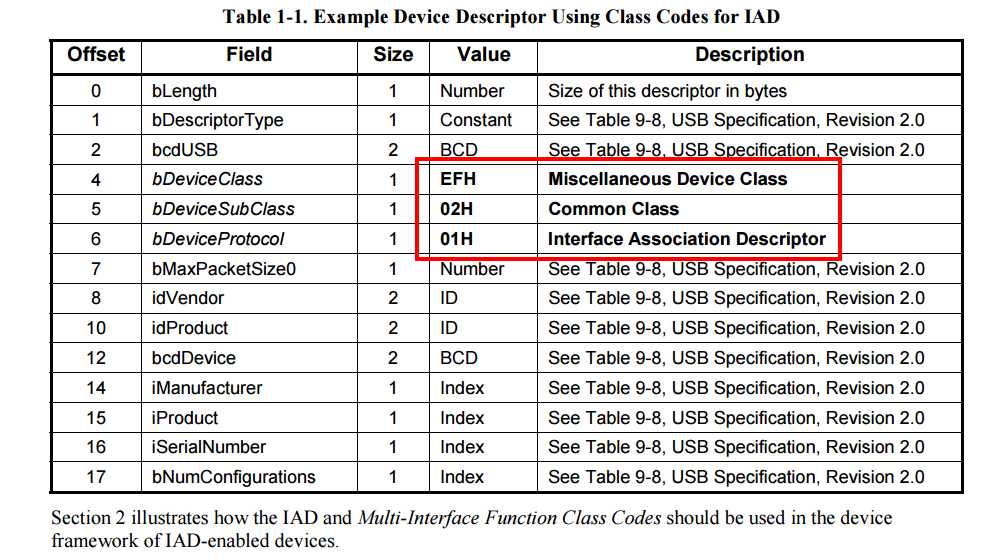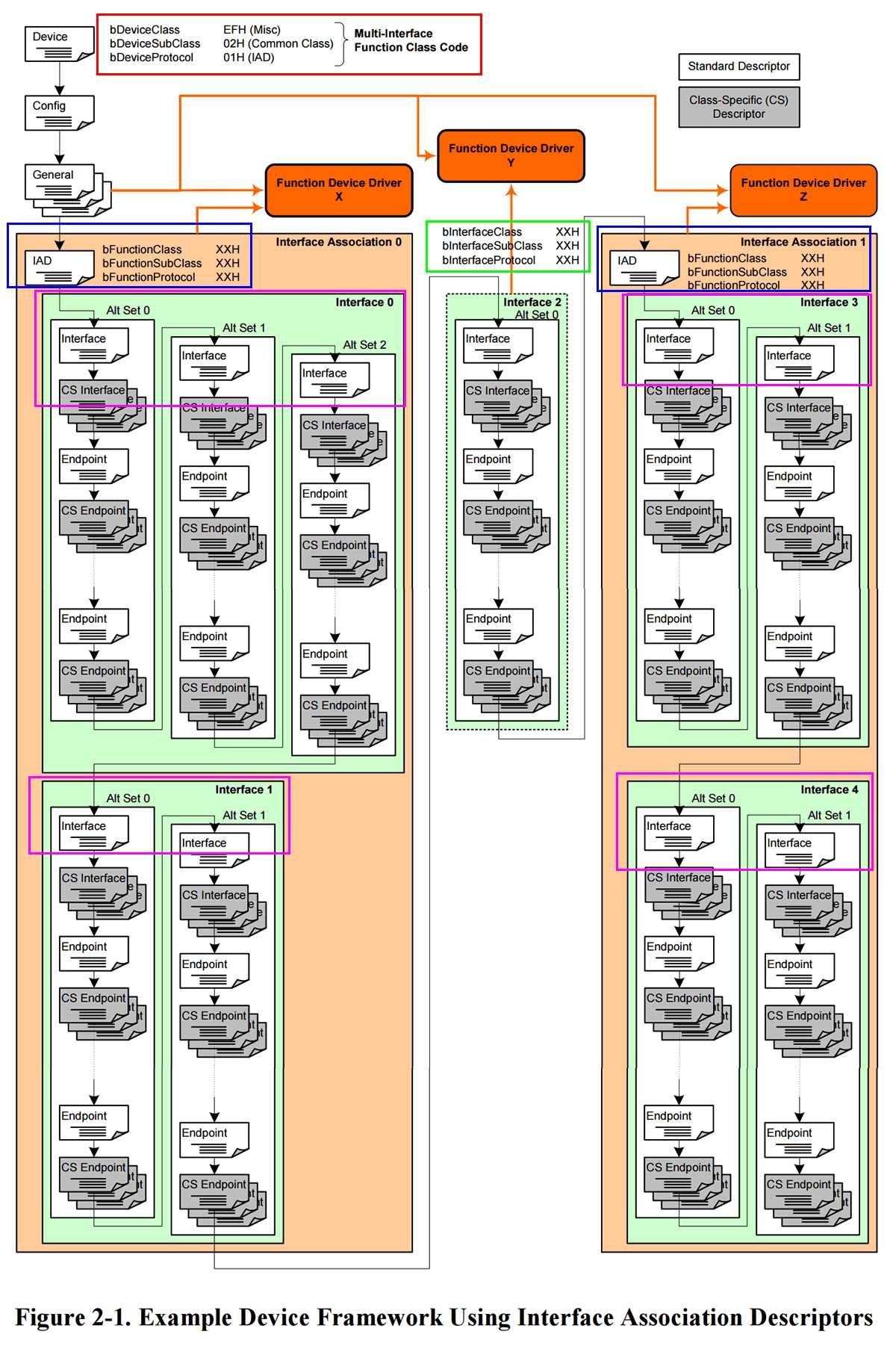USB Composite Device
Connection Status Device connected Current Configuration 1 Speed Full Device Address 1 Number Of Open Pipes 5 Device Descriptor MCP2200 USB Serial Port Emulator
bLength 1 12h 1 bDescriptorType 1 01h Device 2 bcdUSB 2 0200h USB Spec 2.0 4 bDeviceClass 1 EFh Miscellaneous 5 bDeviceSubClass 1 02h Common Class 6 bDeviceProtocol 1 01h Interface Association Descriptor 7 bMaxPacketSize0 1 08h 8 bytes 8 idVendor 2 04D8h Microchip Technology, Inc. 10 idProduct 2 00DFh 12 bcdDevice 2 0101h 1.01 14 iManufacturer 1 01h "Microchip Technology Inc." 15 iProduct 1 02h "MCP2200 USB Serial Port Emulator" 16 iSerialNumber 1 03h "0000133170" 17 bNumConfigurations 1 01h
bLength 1 09h 1 bDescriptorType 1 02h Configuration 2 wTotalLength 2 006Bh 4 bNumInterfaces 1 03h 5 bConfigurationValue 1 01h 6 iConfiguration 1 00h 7 bmAttributes 1 80h Bus Powered 4..0: Reserved ...00000 5: Remote Wakeup ..0..... No 6: Self Powered .0...... No, Bus Powered 7: Reserved (set to one) (bus-powered for 1.0) 1....... 8 bMaxPower 1 32h 100 mA Interface Association Descriptor Abstract Control Model
bLength 1 08h 1 bDescriptorType 1 0Bh Interface Association 2 bFirstInterface 1 00h 3 bInterfaceCount 1 02h 4 bFunctionClass 1 02h CDC Control 5 bFunctionSubClass 1 02h Abstract Control Model 6 bFunctionProtocol 1 01h AT Commands: V.250 etc 7 iFunction 1 00h
bLength 1 09h 1 bDescriptorType 1 04h Interface 2 bInterfaceNumber 1 00h 3 bAlternateSetting 1 00h 4 bNumEndpoints 1 01h 5 bInterfaceClass 1 02h CDC Control 6 bInterfaceSubClass 1 02h Abstract Control Model 7 bInterfaceProtocol 1 01h AT Commands: V.250 etc 8 iInterface 1 00h
bFunctionLength 1 05h 1 bDescriptorType 1 24h CS Interface 2 bDescriptorSubtype 1 00h Header 3 bcdCDC 2 0110h 1.10 Abstract Control Management Functional Descriptor
bFunctionLength 1 04h 1 bDescriptorType 1 24h CS Interface 2 bDescriptorSubtype 1 02h Abstract Control Management 3 bmCapabilities 1 06h 7..4: Reserved 0000.... 3: Connection ....0... 2: Send Break .....1.. Send Break request supported 1: Line Coding ......1. Line Coding requests and Serial State notification supported 0: Comm Features .......0
bFunctionLength 1 05h 1 bDescriptorType 1 24h CS Interface 2 bDescriptorSubtype 1 06h Union 3 bControlInterface 1 00h 4 bSubordinateInterface0 1 01h CDC Data Call Management Functional Descriptor
bFunctionLength 1 05h 1 bDescriptorType 1 24h CS Interface 2 bDescriptorSubtype 1 01h Call Management 3 bmCapabilities 1 00h 7..2: Reserved 000000.. 1: Data Ifc Usage ......0. Call management only over Comm Ifc 0: Call Management .......0 Does not handle call management itself 4 bDataInterface 1 01h
bLength 1 07h 1 bDescriptorType 1 05h Endpoint 2 bEndpointAddress 1 82h 2 In 3 bmAttributes 1 03h Interrupt 1..0: Transfer Type ......11 Interrupt 7..2: Reserved 000000.. 4 wMaxPacketSize 2 0008h 8 bytes 6 bInterval 1 02h 2 ms Interface Descriptor 1/0 CDC Data, 2 Endpoints
bLength 1 09h 1 bDescriptorType 1 04h Interface 2 bInterfaceNumber 1 01h 3 bAlternateSetting 1 00h 4 bNumEndpoints 1 02h 5 bInterfaceClass 1 0Ah CDC Data 6 bInterfaceSubClass 1 00h 7 bInterfaceProtocol 1 00h 8 iInterface 1 00h
bLength 1 07h 1 bDescriptorType 1 05h Endpoint 2 bEndpointAddress 1 03h 3 Out 3 bmAttributes 1 02h Bulk 1..0: Transfer Type ......10 Bulk 7..2: Reserved 000000.. 4 wMaxPacketSize 2 0020h 32 bytes 6 bInterval 1 00h
bLength 1 07h 1 bDescriptorType 1 05h Endpoint 2 bEndpointAddress 1 83h 3 In 3 bmAttributes 1 02h Bulk 1..0: Transfer Type ......10 Bulk 7..2: Reserved 000000.. 4 wMaxPacketSize 2 0040h 64 bytes 6 bInterval 1 00h
bLength 1 09h 1 bDescriptorType 1 04h Interface 2 bInterfaceNumber 1 02h 3 bAlternateSetting 1 00h 4 bNumEndpoints 1 02h 5 bInterfaceClass 1 03h HID 6 bInterfaceSubClass 1 00h 7 bInterfaceProtocol 1 00h 8 iInterface 1 00h
bLength 1 09h 1 bDescriptorType 1 21h HID 2 bcdHID 2 0111h 1.11 4 bCountryCode 1 00h 5 bNumDescriptors 1 01h 6 bDescriptorType 1 22h Report 7 wDescriptorLength 2 001Dh 29 bytes Endpoint Descriptor 81 1 In, Interrupt, 1 ms
bLength 1 07h 1 bDescriptorType 1 05h Endpoint 2 bEndpointAddress 1 81h 1 In 3 bmAttributes 1 03h Interrupt 1..0: Transfer Type ......11 Interrupt 7..2: Reserved 000000.. 4 wMaxPacketSize 2 0010h 16 bytes 6 bInterval 1 01h 1 ms Endpoint Descriptor 01 1 Out, Interrupt, 1 ms
bLength 1 07h 1 bDescriptorType 1 05h Endpoint 2 bEndpointAddress 1 01h 1 Out 3 bmAttributes 1 03h Interrupt 1..0: Transfer Type ......11 Interrupt 7..2: Reserved 000000.. 4 wMaxPacketSize 2 0010h 16 bytes 6 bInterval 1 01h 1 ms Interface 2 HID Report Descriptor Vendor-Defined 1
Usage Page (Vendor-Defined 1) 06 00 FF Usage (Vendor-Defined 1) 09 01 Collection (Application) A1 01 Usage Minimum (Vendor-Defined 1) 19 01 Usage Maximum (Vendor-Defined 16) 29 10 Logical Minimum (0) 15 00 Logical Maximum (255) 26 FF 00 Report Size (8) 75 08 Report Count (16) 95 10 Input (Data,Ary,Abs) 81 00 Usage Minimum (Vendor-Defined 1) 19 01 Usage Maximum (Vendor-Defined 16) 29 10 Output (Data,Ary,Abs,NWrp,Lin,Pref,NNul,NVol,Bit) 91 00 End Collection C0
for the device and generates a PnP event to report the new PDO.
The operating system then queries the bus driver for the hardware IDs associated with the PDO.
For all USB devices, the USB bus driver reports a device ID with the following format:
USB\VID_xxxx&PID_yyyy
The bus driver also reports a compatible identifier (ID) of USB\COMPOSITE, if the device meets the following requirements:
-
The device class field of the device descriptor (bDeviceClass) must contain a value of zero,
or the class (bDeviceClass), subclass (bDeviceSubClass), and protocol (bDeviceProtocol) fields
of the device descriptor must have the values 0xEF, 0x02 and 0x01 respectively,
as explained in USB Interface Association Descriptor. -
The device must have multiple interfaces.
-
The device must have a single configuration.
The bus driver also checks the device class (bDeviceClass), subclass (bDeviceSubClass), and protocol (bDeviceProtocol) fields of the device descriptor.
If these fields are zero, the device is a composite device, and the bus driver reports an extra compatible identifier (ID) of USB\COMPOSITE for the PDO.
After retrieving the hardware and compatible IDs for the new PDO, the operating system searches the INF files.
If one of the INF files contains a match for the device ID, Windows loads the driver that is indicated by that INF file
and the generic parent driver does not come into play.
If no INF file contains the device ID, and the PDO has a compatible ID, Windows searches for the compatible ID.
This produces a match in Usb.inf and causes the operating system to load the USB Generic Parent Driver (Usbccgp.sys).
If you want the generic parent driver to manage your device, but your device does not have the characteristics necessary
to ensure that the system will generate a compatible ID of USB\COMPOSITE,
you will have to provide an INF file that loads the generic parent driver.
The INF file should contain a needs/includes section that references Usb.inf.
If your composite device has multiple configurations, the INF file you provide must specify which configuration the generic parent should use in the registry.
The necessary registry keys are described in Configuring Usbccgp.sys to Select a Non-Default USB Configuration.
USB Generic Parent Driver (Usbccgp.sys)
Many USB devices expose multiple USB interfaces.
In USB terminology, these devices are called composite devices.
Microsoft Windows 2000 and Windows 98 operating systems include a generic parent facility in the USB bus driver
(Usbhub.sys) that exposes each interface of the composite device as a separate device.
In Microsoft Windows XP and Windows Me, this facility is streamlined and improved by transferring it
to an independent driver called the USB generic parent driver(Usbccgp.sys).
Using the features of the generic parent driver, device vendors can make selective use of Microsoft-supplied driver support for some interfaces.
The interfaces of some composite device operate independently.
For example, a composite USB keyboard with power buttons might have one interface for the keyboard
and another interface for the power buttons.
The USB generic parent driver enumerates each of these interfaces as a separate device.
The operating system loads the Microsoft-supplied keyboard driver to manage the keyboard interface, a
nd the Microsoft-supplied power keys driver to manage the power keys interface.
If the composite device has an interface that is not supported by native Windows drivers,
the vendor of the device should provide a driver for the interfaces and an INF file.
The INF file should have an INF DDInstall section that matches the device ID of interface. T
he INF file must not match the device ID for the composite device itself, because this prevents the generic parent driver from loading.
For an explanation of how the operating system loads the USB generic parent driver, see
Enumeration of USB Composite Devices.
Some devices group interfaces into interface collections that work together to perform a particular function.
When interfaces are grouped in interface collections, the generic parent driver treats each collection,
rather than each individual interfaces, as a device.
For more information on how the generic parent driver manages interface collections,
see Enumeration of Interface Collections on USB Composite Devices.
After the operating system loads the client drivers for the interfaces of a composite device,
the generic parent driver multiplexes the data flow from the client drivers,
combining these separate interactions into a single data stream for the composite device.
The generic parent is power policy owner for the entire composite device and all of its interfaces.
It also manages synchronization and PnP requests.
The generic parent driver can simplify the task for vendors of composite hardware,
if Microsoft-supplied drivers support some interfaces but not others.
Vendors of such devices need only supply drivers for the unsupported interfaces,
because the generic parent driver facilitates the use of Microsoft-supplied drivers for the supported interfaces.
The following sections describe the features and functions of the generic parent driver:



